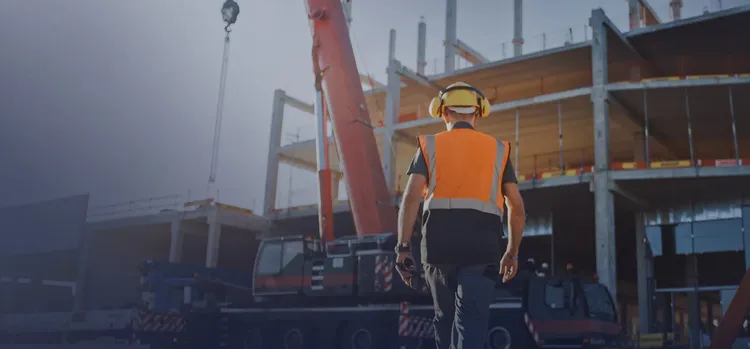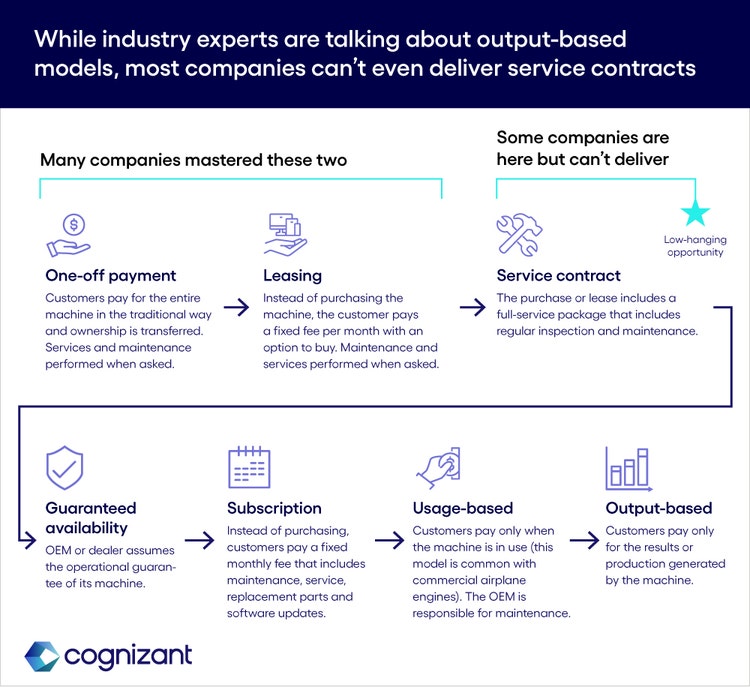
Manufacturers must innovate despite uncertainty styles-h2
<p><br> December 07, 2023</p>
Manufacturers must innovate despite uncertainty
<p><b>Exploring new business models is a crucial step for the industry – even in challenging times.</b></p>
<p>The manufacturing sector has been grappling with a <a href="https://fortune.com/2023/07/03/ism-pmi-manufacturing-recession-jefferies-says-lowest-3-years/" target="_blank">prolonged recession</a>, buffeted by geopolitical and economic headwinds. Unfortunately, this atmosphere of uncertainty shows no signs of abating as we move further into 2023.</p> <p>The causes of this recession are multifaceted and deeply entrenched, exerting pressure on manufacturers' top and bottom lines. Input costs, including energy and commodities, remain high and continue to face potential disruptions, albeit at reduced levels from the historic highs witnessed in 2022. Supply chains offer fresh woes; shattered by the impacts of war and the ongoing pandemic, they remain fragile and susceptible to political volatility in Europe and Asia. Meanwhile, businesses and consumers are adapting to an inflationary world, resulting in weak demand across end markets.</p> <p>Undoubtedly, it is a sombre picture. In such an unforgiving environment, the immediate task at hand for manufacturers is to gain control over costs and safeguard profit margins. However, weathering the storm is insufficient in today's fast-paced world—manufacturers must also keep a keen eye on emerging revenue opportunities.</p> <h4>Embracing new models and streams</h4> <p>The reality is that manufacturers must innovate to address economic uncertainty. To begin, they should reassess and fine-tune their business models to ensure they are adaptable in the present and future. Key questions include: "Which aspects of our current model present insurmountable challenges?" and "Where can we build upon our success stories?"</p> <p>Consider the case of <a href="https://www.sealedair.com/solutions/applications/equipment-automation" target="_blank">Sealed Air,</a> a renowned packaging company known for its iconic Bubble Wrap. Traditionally, the company focused on selling packaging as a product on an order-to-stock model. However, as markets evolve, a product-only approach runs the risk of commoditization.</p> <p>Consequently, Sealed Air shifted its focus towards becoming a solution provider, developing offerings that address broader packaging challenges for customers, such as incorporating package design into services and working closely with customers to integrate their capabilities directly into supply chains. As the industry continues to evolve, Sealed Air is working to lease and sell the underlying packaging equipment to customers, leveraging their expertise and knowledge to deliver the best equipment and technology. As the world around them has changed, so too have their offerings.</p> <p>Drawing inspiration from other sectors that offer customers greater financial flexibility can also provide inspiration. Servitization is a growing part of a wide range of industries (most notably the IT and tech services space), but is still emerging in the manufacturing sector. Nevertheless, opportunities abound. For instance, auto manufacturers can adopt a product-as-a-service model instead of forcing customers to purchase vehicles outright. Although such strategies may present challenges for traditional manufacturers and require significant operational and financial engineering, they are increasingly becoming commonplace. John Deere, for example, <a href="https://www.deere.com/en/finance/financing/landscaping-grounds-care/articles/leasing-101/" target="_blank">leases commercial mowers</a> to customers on a pay-per-use basis calculated according to projected machine usage hours.</p> <p>Another avenue is the release of premium services after sale, such as <a href="https://electrek.co/2019/12/19/tesla-acceleration-boost-model-3-dual-motor/" target="_blank">Tesla's acceleration boost</a> for its Model 3, accessible as an over-the-air software upgrade—or Ford's premium subscription hands-free service.</p> <p>In practice, embarking on a servitization journey is a long process for many companies. Initially, they must enhance their after-market capabilities and drive service transformation. This involves leveraging data to ensure products are consistently operational and deliver the desired outcomes, for instance, by building software solutions that enable consumers to remotely activate the air conditioning in their cars before entering them. Many original equipment manufacturers (OEMs) are missing out on this space.</p> <p>Indeed, as seen in Figure 1, the majority of manufacturers remain constrained by traditional business models—such as one-off payment of leasing—with some finally moving into service contract models that open up new revenue streams. Few have unlocked more evolved models, such as output-based models where customers only pay for the results generated by the machine or product. In short, there are a plethora of transformative models available to manufacturers.</p>

#
<p><span class="small">Figure 1</span></p> <h4>Rebuilding the supply chain</h4> <p>Another area ripe for transformation is the supply chain, which the pandemic and the Suez Canal blockage in 2021 brutally exposed for its fragility.</p> <p>Investments in technologies that enhance supply chain transparency and planning capabilities have surged, according <a href="https://www.cognizant.com/us/en/publications/economist-future-ready/" target="_blank" rel="noopener noreferrer">to our latest research</a>. Digital twins, for instance, enable leaders to assess how outages or blockages impact customers and facilities. Flexibility and agility across supply chains have become primary objectives, with companies ramping up investment in technology to open up new opportunities.</p> <p>One example involves AB InBev, the Belgian drink company, which <a href="https://ab-inbev.eu/news/from-barley-to-bar-ab-inbev-trials-blockchain-with-farmers-to-bring-supply-chain-transparency-all-the-way-to-beer-drinkers/" target="_blank" rel="noopener noreferrer">is piloting blockchain technology with farmers to provide transparency and traceability in its barley supply chain</a>, meeting the increasing consumer demand for sustainability and provenance information.</p> <p>Another benefit of modern supply chains is greater predictability, which allows manufacturers to utilize their facilities more efficiently. Higher utilization rates in warehouses, for example, can create opportunities beyond increased stock storage. Manufacturers may opt to lease their highly efficient facilities, opening new revenue streams.</p> <p>Furthermore, a flexible approach is crucial as the circular economy gains traction and achieving net-zero emissions becomes imperative. Manufacturers must consider not only products leaving the factory but also products returning. Renault, a French automotive group, is leading the way by <a href="https://ellenmacarthurfoundation.org/circular-examples/groupe-renault" target="_blank" rel="noopener noreferrer">planning to build Europe's first circular economy factory</a>. Their innovative approach involves implementing a reverse logistics ecosystem to extend the lifespan of products and components.</p> <h4>New tech and pragmatic solutions</h4> <p>The key to supporting innovation in a volatile economic landscape lies in deploying digital technology to facilitate pragmatic approaches to business. For example, rather than integrating systems, manufacturers can automate data flows between them, reducing costs while enhancing outcomes. Or by designing intelligent cloud migration roadmaps, they can <a href="https://www.cognizant.com/us/en/case-studies/etex-sap-migration-azure" target="_blank" rel="noopener noreferrer">trim expenses while improving system performance.</a></p> <p>To illustrate, let's consider agricultural equipment manufacturers. Transitioning to an as-a-service model requires substantial capital investment. Manufacturers must restructure their systems to accommodate a more circular supply chain and develop new analytics capabilities to monitor usage and maintenance requirements.</p> <p>Funding such transformation initiatives might appear daunting. However, by intelligently deploying technology and embracing pragmatic solutions, manufacturers can reallocate resources from other areas within the business. This not only enables cost optimization but also unlocks new revenue streams.</p> <p>Budget constraints should not impede progress in an industry where cost control is an ever-present pressure. Manufacturers have demonstrated their ability to create practical tech roadmaps that strike a balance between effective solutions and innovative approaches.</p> <h4>A steady path to industry 4.0</h4> <p>The factory floor represents an area where digitization can yield significant efficiency gains. Although the current economic uncertainty may not be conducive to a full transition towards fully automated smart facilities, there are still benefits to be realized through ongoing digital transformation efforts.</p> <p>Manufacturing executives understand that downtime equates to financial losses. Pausing production to replace legacy technologies and machinery with modern capabilities is often economically unviable. However, certain areas, such as monitoring and predictive maintenance, offer opportunities for development without extensive costs—and will be vital to support new revenue streams, such as utilization models were manufacturers only profit when machines operate as planned.</p> <p>Here pragmatism remains key—for example rather than replacing analog monitoring systems and machinery with new digital equivalents, manufacturers can leverage existing technologies combined with artificial intelligence to achieve comparable outcomes.</p> <h4>A pragmatic approach to progress</h4> <p>Intuition might suggest that the best course of action for manufacturing leaders during uncertain times is to adopt a wait-and-see approach. However, with no end in sight, postponing all transformation activities can be perilous. History shows that disruptions often create winners and losers within an industry.</p> <p>Given the limitations of radical actions and the risks associated with volatile markets, a pragmatic approach that prioritizes the search for new business models and revenue streams through the deployment of new technologies and approaches emerges as a viable third path for manufacturers. By striking a balance between pragmatism and innovation, manufacturers can successfully navigate through challenging times and position themselves for long-term success.</p> <p>In summary, manufacturers must embrace new business models and revenue streams to navigate the ongoing economic uncertainty. This involves reassessing and fine-tuning existing models to adapt to evolving market demands. Manufacturers can draw inspiration from sectors that offer customers greater flexibility, such as adopting a product-as-a-service model or offering premium post-sale services.</p> <p>Digital technology plays a crucial role in supporting innovation and pragmatic solutions. Manufacturers can automate data flows and integrate intelligent cloud migration roadmaps to optimize costs and enhance system performance. Despite budget constraints, manufacturers can reallocate resources and strike a balance between effective solutions and innovation.</p> <p>On the factory floor, digitization can yield efficiency gains through ongoing digital transformation efforts. Areas like monitoring and predictive maintenance offer opportunities for development without extensive costs. While a full transition to smart factories may not be feasible in the current economic climate, incremental progress can be made.</p> <p>The supply chain is another area for transformation, with investments in technologies that enhance transparency and planning capabilities. Greater predictability within the supply chain allows for higher utilization rates and potential opportunities to lease facilities. Embracing the circular economy and focusing on sustainability also opens up new avenues for manufacturers.</p> <p>An approach that combines innovation and pragmatism is essential for manufacturers to thrive in uncertain times. By embracing new models, leveraging digital technologies, and focusing on efficiency and sustainability, manufacturers can navigate the challenges and position themselves for long-term success.</p> <p><i>To learn more, visit the </i><a href="https://www.cognizant.com/us/en/industries/manufacturing-technology-solutions" target="_blank" rel="noopener noreferrer"><i>Manufacturing section</i></a><i> of our website or </i><a href="https://www.cognizant.com/us/en/about-cognizant/contact-us" target="_blank" rel="noopener noreferrer"><i>contact us</i></a><i>.</i></p> <p><i>This article was written by Ernie Kim, Cognizant’s Vice President of MLEU Strategy, and Ollie O'Donoghue, Senior Director, Cognizant Research.</i></p>
<p>We’re here to offer you practical and unique solutions to today’s most pressing technology challenges. Across industries and markets, get inspired today for success tomorrow.</p>
